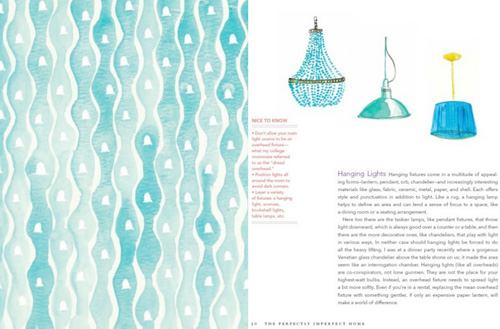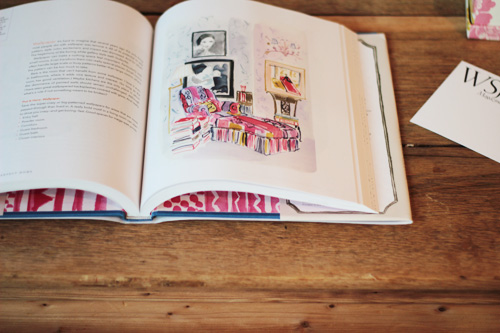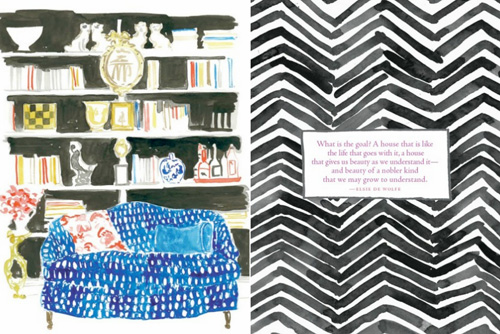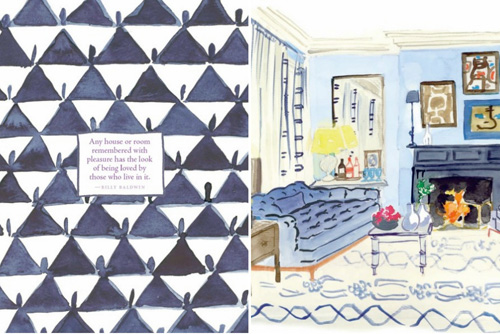Chatting With Deborah Needleman: The Perfectly Imperfect Home
There are tons of beautiful decorating books that just hit stores in time for the holidays and as a result, it's so hard to choose the perfect one! That's why I thought I'd make it easier for you! I recently had a lovely chat with Deborah Needleman, author of newly released and very girly interiors title, "The Perfectly Imperfect Home" published by Clarkson Potter Books and illustrated by Virginia Johnson, and thought I'd share it with you today...

But first, my thoughts on her latest pride and joy. This decorating book is different because there are no photographs but please don't let that put you off -- what it does have is beautiful watercolor illustrations of room and objects by Virginia Johnson, a Canadian artist and designer whom I've followed ever since I started blogging. In fact, I once worked for domino, the magazine the Deborah founded, from 2006 until it folded a few years later and I always loved the overall message behind the magazine and wondered where Deborah would go from there after leading such a successful adventure in print... And now here she is on her second book. Go, Deborah, go!
The Perfectly Imperfect Home is a really pretty coffee table book filled with lots of helpful decorating tips that Deborah has learned over the years from her work at domino and now WSJ. Magazine. When you combine her knowledge with colorful illustrations of the rooms that you may remember from her first book and from domino magazine, you have the recipe for a successful title. I loved seeing some of my favorite rooms created into works of art through Virginia's talented hand. The illustrations really made the book (for me at least) because I found them just so pretty to look at. In fact, I got so lost in the illustrations, examining them over and over again, that I nearly forgot to read the text. I think Deborah could have told me to do anything in this book, jump off a bridge, run naked in the park, and I wouldn't have even noticed because all of the illustrations swept me away. I did read some of the book though and of course, the text is helpful and written in a very relaxed and personal tone and didn't come across as preachy or textbook. This is a book that is purely inspirational for me above everything else and though I'd hate to take it apart, the thought has crossed my mind to cut out my favorite images and frame them because many are too lovely and girly to not show on a wall.
When Deborah's publisher sent me a copy to review, I knew I had to chat with her personally to learn more about the book and to learn of her inspirations behind-the-scenes. Care to listen in? Great! Then pull up a chair please and lets chat with domino's one and only Ms. Needleman.
Holly: What are you up to these days, Deborah?
Deborah: I'm the Editor in chief of WSJ. Magazine and also created and oversee a Saturday lifestyle section for the Wall Street Journal called OFFDUTY.
Holly: What is your background - where did you study and how did that affect your career decisions today?
Deborah: I studied philosophy in college. I always thought that had nothing to do with my career path, but now I think it may have everything to do with it. I am interested in the principles behind things and the structure of things. What makes a great room? A beautiful house? What makes a good magazine? A strong brand? A coherent mission for a company? My passion is in making things, little eco-systems really. I’m not a part of any ‘industry’—the decorating industry, the fashion industry, the garden industry, but I work in all of them. I’m driven by how to deliver information and inspiration to people in a satisfying and exciting manner. My career choices have all been driven by trying to do something that makes me happy—photography, gardening, writing about great gardens, creating an unsnobby, but chic magazine that would help me, and others, learn how to decorate better, etc.
Holly: When I read the first page of your book, I couldn't help but feel sad because you mentioned your childhood and how perfect your home was and that it never felt cozy as a result - things only changed when the decorators were called in. I grew up just the opposite, my mother was constantly decorating and I was either assisting her or doing my own decorating projects and for me, this began around age 7. Yet, you and I share the same quest - to help people to find their comfort in the home and to create a home with personality that also fits their lifestyle. I wonder, when did you figure out that your childhood views of decorating were what drove you as an adult to flip those views upside down and encourage others to do the same, "imperfectly perfect" living as you call it? Was this a recent discovery or one you've always known? Do you think growing up in a perfectly perfect home is what got you into design writing in the first place?
Deborah: It is interesting! Some people learn by example from strong role models, and other people are like me and learn just by saying, ‘NO! NO! NO!’ in a rather bratty way to what’s around them. I grew up in a new cookie cutter suburb where all the trees (and houses, for that matter) were about as old and mysterious as I was. (ie. Not very!) I developed a passion for gardens--for beautiful, mysterious, wild, grand gardens, but I had never seen one. I had only seen suburban lawns and limited palette, low-maintenance planting schemes created by teams of landscaper/contractors. I had read about gardens, and they struck my imagination powerfully, and my passion developed out of fantasy and desire, rather than from what I knew or had experienced. Eventually I got to travel the globe writing stories for House & Garden magazine on some of the most wonderful gardens in the world. Similarly, all the houses I knew were neat and orderly and not very interesting. I remember our next door neighbor, who was a wacky lady, had one of those 70’s poems—“If you love something set it free, if it comes back to you, it’s yours forever…” printed in calligraphy and hung on the wall, and I thought, ‘Cool! How personal! How unusual.’ We had nothing personal or quirky in our house. So again, I just said ‘no!’ to the repressed, boring houses I knew, but I didn’t know how to get that effortless, cool style I craved, so I started a magazine to help me and others learn. While you are helping people learn what you know, I am helping people learn what I want to learn! But to do that one needs people like you Holly, whose mothers were an inspiration. All the top editors at domino had mothers with great style. I’m basically sharing what I learn, as I learn it. That’s what excites me. Now I’m immersed in the worlds of culture and of fashion. They are new frontiers for me.
Holly: What made you want to write a second decorating book?
Deborah: I wanted to do a book that addressed decorating from the point of decorating, not from its result. The point of decorating so far as I can tell is to create the best backdrop for the life you want to lead. If we start thinking about our homes from what we want it to do and convey---instead of from ‘cool chair’ or ‘pretty fabric’—then we can make homes that really grow out of who we are, and that truly inspire us.
Holly: What gave you the idea to have a decorating book with only illustrations of rooms vs. photographs?
Deborah: People keep asking that and it’s funny because it never occurred to me to use photographs. This is a book about ideas, not about particular things. If you want to look at photos to get ideas for rooms, there are loads of books that do that beautifully. The illustrations allow the reader to think about the ideas, the principles, rather than going deep into all the particular things that someone may have. This way each image ‘illustrates’ a point. A photograph has a million points of reference in it—and I personally can get lost in that.
Holly: How long did it take you to accomplish this project?
Deborah: This book took much longer than I thought because coordinating all the art with Virginia was a huge project. I looked through what felt like zillions of pictures to find the rooms I thought best expressed the ideas and the feelings I was after. Then I would scan and annotate them so that Virginia could understand what I was hoping to convey in each picture. She is absolutely brilliant, and could do a painting in about the time it took me to slog through all the labeling and uploading and technical nightmares.
Holly: Virginia (your illustrator) lives in Canada from what I recall, did you work mostly through email and if so, what were some of the challenges of that and how did you meet them?
Deborah: We did the whole thing over email. We’ve only met once. She is truly remarkable and talented and lovely.
Holly: I imagine it took her a long time to take the images of spaces that you sent to her and then, have her turn them into watercolors. On average, how long did it take her to turn a photo into a watercolor?
Deborah: She could create a chapter—about 12 illustrations—in two weeks—all while she was running her business, getting married, moving house and having a baby.
Holly: How many watercolors are in the book?
Deborah: There must be over 200 paintings in the book.
Holly: When you were the managing editor of domino, many knew who you were and what you were about - and you had a following! These days, not everyone follows your WSJ work as religiously as domino for obvious reasons -- the appeal of domino was that it was something we could collect and look forward to at the same time each month. Do you think you'll ever bring domino back? Do you think you've moved on or do you still imagine running your own magazine again someday? Thoughts?
Deborah: I feel as satisfied making WSJ magazine as I did making domino. It’s been a great challenge, as was domino. While we didn’t start this magazine from scratch, but I do feel like we’ve completely re-imagined it. It’s a different set of subjects and a different audience, and yet I’m reaching many of the same people, in addition to new people. It’s immensely satisfying. I have no desire to go backwards. If I felt like domino was unfinished business, maybe I’d feel differently, but I don’t. We made the magazine we set out to make. We grow, we change, the world changes, we’re on to the next thing.
Holly: Can you tell us about your personal style?
Deborah: My style is layered and elegant and a little messed up. I like nice things treated unpreciously. I’m sitting now with my feet up on a big antique suzani-covered ottoman, it’s piled with books, magazines, and games, a fire is crackling, the late afternoon light is shooting through some ruddy-leaved privet branches in a big glass container and sending long shadows across the floor and rug. I’m sitting on a purple linen, tufted sofa with soft pillows made from old sari fabric squished behind my back, my laptop is on lap, and there’s a slightly too cold cup of coffee nearby that I wish was warmer. I think that’s my style.
Holly: What are a few of your favorite things at home?
Deborah: All my favorite things are sentimental. Nothing else is dear to me. I love a big blue ceramic pumpkin and a small stuffed leather bull I found with my husband at a shop on Rue Jacob in Paris we love. He just got me a fantastic 19th century naïve painting of an owl for my birthday a few days ago. I am crazy about big heavy linen tablecloths—they are not sentimental, just really, really nice. I try to make everything I have and use be attractive, so it makes me happy to look at it, or at least not annoyed. There is that great quote from William Morris: Have nothing in your house that you do not know to be useful, or believe to be beautiful. But that’s not always possible: I’m talking to you ancient orange le creuset pots and Swiss Army wheelie luggage.
Holly: What's next for you?
Deborah: I always like to have a plan B. This week’s fantasy plan is to open a little shop in our town in the Hudson Valley that serves simple, good food, sells flowers in jam jars and maybe little paintings and things made by friends, and basic things like toilet paper and newspapers. And maybe it has a small cutting garden where people can pick their own flowers. And at night, there should be tables outside and good music and good times and sparkly lights in the darkness. This idea may have floated away by next Monday. I just have to be doing something I’m interested in, feel good about, and feel creative doing.
Thank you Deborah - so, so much and congratulations on your beautiful new book. I wish you loads of luck with it and have a wonderful season!
(images: photos: holly becker, others: clarkson potter)






